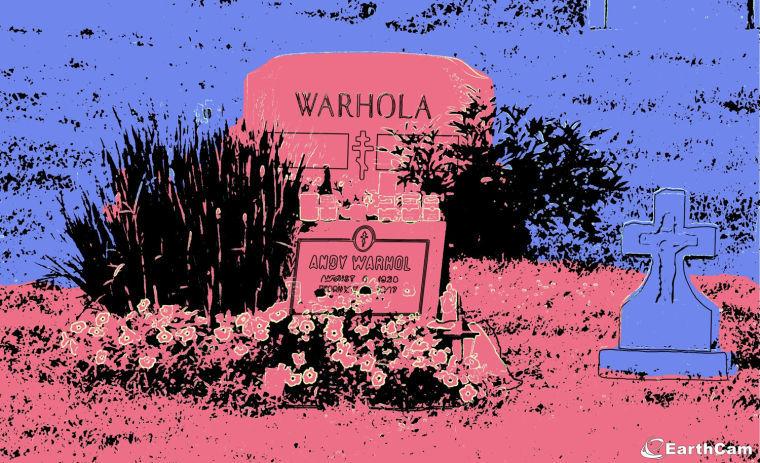Welcome Back: A Warhol-esque project, starring Andy Warhol
August 18, 2013
Brian Cury likes to tell people that he enjoys bringing postcard views to life, and as the founder and CEO of EarthCam, he gets to do just that. The company maintains and operates live webcam feeds of famous locations such as Times Square and Abbey Road Studios.
Now, EarthCam is bringing another postcard view to life, albeit one of a man who has since deceased.
Since his Aug. 6 birthday, the grave of Andy Warhol, the Pittsburgh native whose art made him a cultural icon in the 1960s, is viewable online at any time thanks to the combined efforts of EarthCam and the Andy Warhol Museum on a project called Figment.
The idea came from a conversation between Cury and Eric Shiner, the director of the Warhol Museum. After setting up live camera exhibits at the museum in the past, Shiner and Cury were thinking about “the next great place to put a camera” and decided on Warhol’s resting place in Bethel Park’s St. John the Baptist Byzantine Catholic Cemetery.
“As far as we are aware, this is the only camera that shows a grave site 24 hours, seven days a week,” said Joshua Jeffrey, the Warhol Museum’s manager of digital engagement. “And with that came some interesting challenges.”
According to Cury, putting the cameras up was the easy part. With the help of the cemetery’s gravedigger, power lines were buried after being laid through the cemetery in the most unobtrusive means possible. Once powered, the cameras then rely on 4G data service to transmit the images they capture.
Additionally, the cameras are not only able to record, but can also take detailed snapshots and add effects that give the images a pop-art look, providing what Cury calls a “very Warhol-like screen print effect.”
“What you’re seeing when you’re looking at that experience there is the best of our technology,” he said.
As of now, Jeffrey says Figment is slated to continue indefinitely, with no reason to end the project in sight. EarthCam has also agreed to continue to maintain and operate the cameras and other technology necessary to keep it operational.
The project’s name pays homage to a Warhol quote from his book, “America,” in which the artist said he was never able to understand why people don’t vanish when they die because the world keeps going about its concerns, just without the deceased. He said that he didn’t want an epitaph or name on his tombstone and would prefer it to be blank.
“Well, actually, I’d like it to say ‘figment,’” the quote ends.
Jeffrey’s preferred interpretation of the quote sees the greatest work of Warhol as Warhol himself.
“He really created a persona and created an image in the 1960s around which he created his work. And he was maybe wanting people to look back at him in the future and remember his imagination,” Jeffrey said. “He wanted them to look at him as more than just a person.”
The site comes with a Remember Andy button. After clicking it, users can send Campbell’s Soup or flowers to Warhol’s grave through PayPal. EarthCam then notifies users by email when the gifts are delivered so they can watch online as the delivery occurs.
For Cury, the project, which EarthCam financed in its entirety, is a way of giving back and creating art with technology.
“Andy partially inspired me to create EarthCam through conversations I had with him in the ‘80s. I had these amazing conversations with him about how television influences fame,” said Cury. “Just watching something live on television, that image or that person becomes famous just because they’re in that electronic medium.”
Warhol’s nephew, Donald Warhola, also thinks the project is in line with his uncle’s artistic ventures. He thinks that his uncle, upon seeing the camera that now broadcasts his resting place, would have said, “‘Oh gee, I should have thought of that!’”
Warhola says his uncle didn’t set limits on what he captured as part of everyday life and its various angles. That being said, he feels that the live camera feed is an apt, no-limits way for fans and admirers to pay tribute to Warhol at his grave, even if they can’t travel there.
“I go up there and find solace and peace,” he said. “So, I thought, why not allow more people to have that opportunity that can’t get there geographically.”



